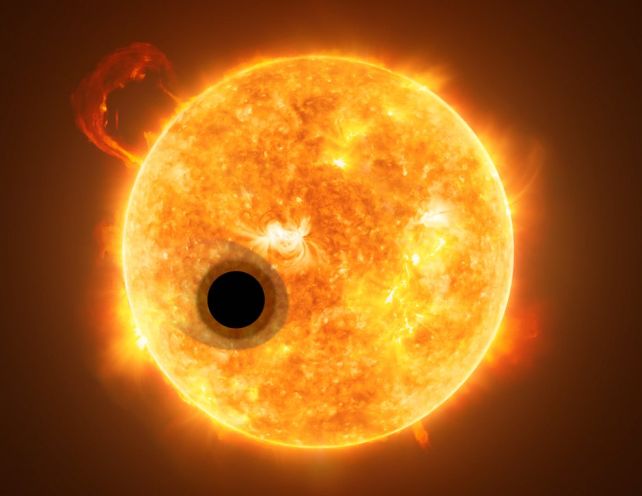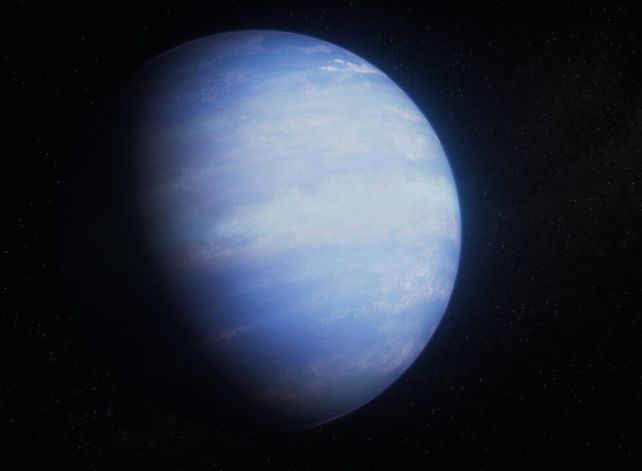There are worlds out there far stranger than those we might dream up – and a real oddball we've been studying in puzzlement for years just got even odder.
Its name is WASP-107b, an exoplanet orbiting a star just 200 light-years away, and it caught humanity's attention for its unusual composition. WASP-107b is 96 percent of the radius of Jupiter – and less than a tenth as dense as the Solar System's already not-very-dense gas giant.
Now, a new analysis has revealed that this extra-puffy 'popcorn' planet has an asymmetrical atmosphere, with significant differences between the eastern edge and the western. And the method used to find that asymmetry could help reveal more wonky exoplanets in the future.
"This is the first time the east-west asymmetry of any exoplanet has ever been observed as it transits its star, from space," says astronomer Matthew Murphy of the University of Arizona.
Exoplanets – that is, planets outside our Solar System – are pretty difficult to study in detail.
They're very far away, very dim, and usually seen in close proximity to a star, whose blinding light can obscure information. But, if the system is oriented in such a way that the orbiting exoplanet passes between us, the viewers, and its star, then the star's light becomes the tool with which we can probe the exoplanet's atmosphere.

When the exoplanet passes in front of the star – an event known as a transit – some of the star's light passes through the exoplanet's atmosphere. Some wavelengths can be absorbed and re-emitted by atoms and molecules in its atmosphere, resulting in lighter and darker lines on the spectrum of light collected by our instruments.
This data, as you can imagine, is pretty faint. Only the tiniest fraction of a percentage of all the light emitted by a star passes through the atmosphere of a transiting exoplanet, and is altered by it. Nevertheless, thanks to this method, we now know some of the atmospheric elements in quite a few exoplanets.
WASP-107b was discovered in 2017, and we know a few things about it. Its size and density suggest a composition similar to cotton candy. It's also really close to its star, an orange dwarf, with an orbital period of about 5.7 days. This makes it scorching hot, around 500 degrees Celsius (930 Fahrenheit).
It also means it is tidally locked: one side of the exoplanet is locked into facing the star at all times, in permanent day; the other is in permanent night. This could mean that its dawn and dusk terminators – the line that separates night from day – have different compositions.
We already know a little bit about what's in the exoplanet's atmosphere. Previous peeks using the JWST revealed sulfur dioxide, water vapor, carbon dioxide, carbon monoxide, and clouds of sand.
Murphy and his colleagues wanted to take a step further. Using new analysis techniques and data from JWST, they were able to discern differences in the atmospheric composition between the exoplanet's eastern and western hemispheres.

We've seen asymmetry in exoplanet atmospheres before. In ultra-hot exoplanets, it's thought to be because the atmosphere rotates around the globe; when it reaches the dawn terminator, it heats up; when it reaches the dusk terminator, it cools down, condenses, and maybe even rains.
Those discoveries were made using different techniques. This new discovery is a breakthrough. The researchers were able to detect not just a difference in temperature on the two sides of the exoplanet, with the morning being cooler than the evening, but also a slight difference in cloud opacity.
This is fascinating, because models suggest that WASP-107b shouldn't have that kind of asymmetry. But more observation and analysis will be needed to dig into the finer details, such as how this asymmetry plays out in the exoplanet's chemical composition.
Meanwhile, there's a whole galaxy out there, with other exoplanets flaunting their atmospheres, waiting for their turn in the spotlight. The new techniques the team used could tell us more about them, too.
"This is really the first time that we've seen these types of asymmetries directly in the form of transmission spectroscopy from space, which is the primary way in which we understand what exoplanet atmospheres are made of," explains astronomer Thomas Beatty of University of Wisconsin-Madison.
"It's actually amazing."
The research has been published in Nature Astronomy.
